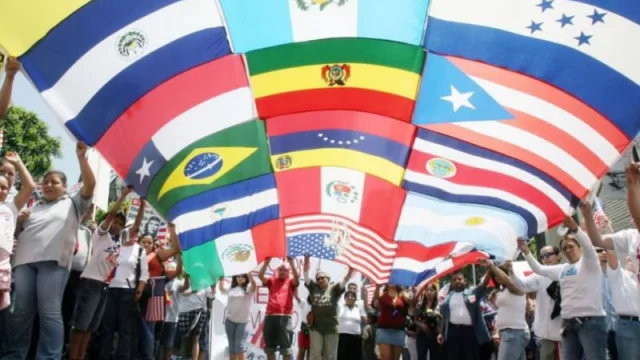It is vital to analyze this problem without bias or prejudice, but from reality and casuistry. There are certain policies that have been shown to be much more effective in improving job creation and increasing income in different countries, regardless of their political orientation. In general, liberal and market economies tend to have higher per capita income and GDP levels than socialist economies. This is because liberal economies promote investment, innovation, competition, and efficiency.
The data shows an immense differential reality.
-
The average salary of workers is much higher in the USA than Latin American socialist-oriented countries.
The average salary of a worker in the United States is around US$56,000 per year, according to data from the US Bureau of Labor Statistics. This number varies depending on the industry, region, and level of education and experience of the worker.
In the case of Florida, the average annual salary is around US$53,000 per year, according to data from the same source. Again, this can vary depending on the industry and other factors.
In Latin America, average salaries vary significantly between different countries and regions. According to data from the International Labor Organization (ILO) for 2020, the average monthly minimum wage in Latin America was around $300, although this can vary widely between countries. Some countries, such as Uruguay and Chile, have higher average wages than others, while other countries, such as Bolivia and Paraguay, have lower average wages. It is important to note that these data are only an approximation and can vary significantly depending on the industry and the level of education and experience of the worker.
Data from Statista.com, based on Bloomberg surveys.
*On this information from March 2023, Argentina in April drastically lowered its salary even further, following the growth of the blue dollar quotation (real parallel market).
-
The number of hours worked by an average worker varies depending on the country and region. In general, workers in the United States and Florida work more hours on average than in many Latin American countries.
According to data from the International Labor Organization (ILO) for 2021, the average working hours per week in Latin America are around 40 to 45 hours, although this can vary widely between countries. For example, in Mexico, the average working hours per week were around 43 hours, while in Colombia and Argentina it was around 48 hours.
In the United States, the average working hours per week are around 34 to 38 hours, although this can vary depending on the industry and the type of work. In Florida, the average working hours per week were similar to those in the United States in general, around 35 to 38 hours per week.
-
The obsolescence of labor laws and the incoherence of unions generate more informality, work without legalization, and less formalization of social benefits in Latin America than in liberal economies. In addition, real unemployment rates, not "declared" ones, are drastically higher in countries such as Argentina, Venezuela, Colombia, Nicaragua, Bolivia, and Peru.
Unemployment rates
-
The average unemployment rate varies by country and region. In general, the United States and Florida have lower unemployment rates compared to many Latin American countries. According to data from the US Bureau of Labor Statistics, the unemployment rate in the United States in April 2023 was 3.5%. In Florida, the unemployment rate in March 2023 was 3.9%, but it has been decreasing and will be below the US average in May, according to data from the Florida Department of Economic Opportunities.
In Latin America, unemployment rates vary widely among countries. According to data from the ILO for the year 2021, the average unemployment rate in Latin America was 9.6%. Some countries, such as Mexico, had a lower unemployment rate, while others, such as Argentina, had higher unemployment rates. Although the latest information from Argentina shows a rate of 6.3% (according to Statista, it currently exceeds 9%), these data have not been considered accurate, as many people in Argentina are not actively seeking work due to the large number of social welfare programs available. This situation also occurred in Venezuela, which now has an unemployment rate higher than the projected rate in 2019 of 44%, a country that no longer provides information and, according to the UN, has a poverty level exceeding 87%.
Data from Statista.com.
What should Latin America, regardless of any political party ideology, do to have a real plan for job creation, wealth and living standards improvement for its population?
The following are the key policies that can help improve job creation and increase incomes in Latin America, based on successful policies of other countries outside of the region such as Ireland, Australia, New Zealand, United Arab Emirates, Saudi Arabia and most of the Nordic countries.
The first step is to encourage private investment through fiscal and regulatory policies that reduce uncertainty and the costs of doing business.
But to achieve this, it is necessary to develop physical and digital infrastructure to improve connectivity and productivity for businesses.
-
Promoting education and technical and professional training to improve skills and productivity of workers is also crucial, as is promoting innovation and the development of advanced technologies to improve the competitiveness and efficiency of companies.
-
Promoting economic diversification and productive specialization to take advantage of each country's comparative advantages, facilitating access to credit and financial markets for companies and entrepreneurs, promoting formal employment to improve social protection and labor rights of workers, and flexibilizing labor laws according to the current reality of flexible work types and the market demands are other essential steps to take.
-
Other important policies include promoting international trade and regional integration to take advantage of market opportunities and increase competitiveness, promoting financial inclusion and entrepreneurship to foster the creation of new businesses and jobs, implementing social policies that reduce poverty and inequality, which can improve internal demand and social stability.
-
The creation of self-sufficient agricultural, energy and productive communities without resources, the promotion of productive school and family cooperatives for regional economies, and focusing on macroeconomic stabilization are all vital.
-
Latin America has experienced high inflation and currency devaluation in recent years, especially Argentina and now Colombia. A policy that seeks to reduce inflation and stabilize the exchange rate could improve investor confidence and encourage investment.
-
Latin America, except for countries such as Uruguay, has a high level of public debt that limits its capacity to invest in infrastructure and education, and a responsible fiscal policy that seeks to reduce the deficit and improve the efficiency of public spending could contribute to improving public finances and macroeconomic stability.
-
Regulatory reforms and an institutional framework that do not limit competition and productivity are also essential.
-
Opening up to the world is vital.
-
Structural reforms: It is vital to have regulation and an institutional framework that does not limit competition and productivity. Opening up to the world is vital to generate a large market. Chile and Mexico are already advanced in this regard, but countries like Argentina, Bolivia, Colombia, and Venezuela require a series of structural reforms that aim to reduce trade barriers, increase market efficiency, and improve the quality of institutions, which could improve the business climate and encourage investment.
-
Promoting foreign investment: Latin America has enormous potential to attract foreign investment, but it needs to improve its legal security and political stability to do so. A policy that promotes foreign investment could help create jobs and improve the productivity of companies.
-
Latin America needs to improve its ability to innovate and develop advanced technologies to enhance the competitiveness of its companies. A policy that promotes innovation and technological development could improve the productivity and competitiveness of Argentine companies.
-
Promoting financial inclusion and entrepreneurship: A policy that promotes access to credit and financial markets for entrepreneurs and small businesses could contribute to improving employment and productivity.
-
Promoting economic diversification and productive specialization: Latin America is rich, but historically its countries have been dependent on exporting raw materials. A policy that promotes economic diversification and productive specialization could improve the competitiveness of the entire Latin American economy and generate new employment opportunities.
-
Avoiding state corruption, the ideologization of macro and microeconomics, and avoiding biases of populism.Confronting real information as a natural element to accept and not combat with mechanisms of political bias communication. The impeccable administration of resources is the great and only first weight and sustainable variable for the clarity of internal and external public policy, which then allows for other policies.


Tu opinión enriquece este artículo: